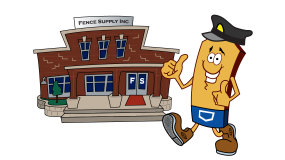When building a driveway gate you have two basic options a sliding gate or a swinging gate.
Both are great options, and can be beneficial for a variety of reasons, but depending on the details of your particular project one may be better than the other. If you’re unsure which type of gate that you want, please read through the definitions below to decide which step to take next.
Let’s take a look at the details of each:
Swinging: A swinging gate is great for most short lengths, and is most efficient for gates 14 feet long or less. If your gate is 10 feet or less, constructing a single gate is a viable option, offering a stable frame and little drag or resistance. If your gate will be automated, using a rubber bumper or positive stop is a good idea.You shouldn’t go more than 12 feet long with a swinging gate.
If your gate’s length is 10 feet or more, constructing a double-drive gate is the best option for swinging gates extending 10 feet to 20 feet. If your fence doesn’t need automation, you could build up to a 20 foot gate. If your gate is going to be more than 20 feet long, we recommend a sliding v-track gate.
Sliding: A sliding gate is great for any length of gate, but the benefits especially show with lengths of 14 feet or longer. Fence Supply Inc. recommends using the v-track system, offering an easy-to-install, easily expandable option. It can be opened manually without a gate opener, but allows for the addition of a future gate opener. It will also stay stable in high winds. If you will be opening your gate rarely, for example a few times a month, then you don’t really need an automatic gate. But if your gate will have frequent use, or is longer than 10 feet, we recommend using an automated gate.
__________________________________________________
V-track Gate
When constructing a sliding gate for a wood fence, we recommend using a V-track gate to create a long-lasting, well-built gate that will work in almost any situation. This option uses a set of wheels and guide rollers to seamlessly glide over a stable iron track. V-track gates ensure stability and alignment, and are much more effective when compared to some of the commonly found homemade options that are constructed from 1-inch angle iron and flat plates.
To assemble and create your V-track gate, we recommend the following steps:
1. Installing your posts properly will be integral to building a solid, long-lasting gate. For a six-foot tall gate, use a 4″ x 4″ x x 10′ post. For an eight-foot gate, use a 4″ x 4″ x x 12′ post. To determine the width at which you bury the posts, take a measurement of all your materials (the guide rollers, the steel frame, the wood, etc.) and then add ½ inch.
The ideal installation will use 5 posts:
a. 1 latch or catch post
b. 4 guide posts
The minimum recommended depth for posts to be buried is 3 feet. This depth should increase in poor soil conditions.
This post layout offers the most secure and safe installation. With four guide posts, the gate is literally caged-in, and has no chance of falling over or coming off of its track. This installation also makes it virtually impossible for the gate to by lifted or removed.
2. The foundation for your V-track gate system is vital to ensure that your gate works properly and effectively. It’s important to keep the V-track as level as possible so that the V-wheels can glide properly over the track. Fence Supply Inc. recommends installing a 12-inch wide by 6-inch thick concrete support curb as a foundation beneath your V-track, wherever it will be driven over.
If concrete is not an option for your project, here are a few alternatives:
- I-beam with post supports
- Asphalt. This option must be secured with 3/8 rebar. The r-bar should be driven 12 inches deep and flush with the V-track, and puddle-welded onto the V-track. This option should only be used when securing to concrete is impossible. The longevity of this option will be determined by type of vehicle traffic.
3. The V-track itself is a specialized, pre-molded solid strip of galvanized steel. The V-track is pre-drilled with holes every 12 inches.
4. Two V-wheels are necessary per gate. While additional V-wheels may seem to be beneficial, Fence Supply Inc. recommends never using more than two V-wheels, as it’s actually counterproductive and can cause alignment damage to your gate. For a six-foot gate, a four-inch Kodiak V-wheel is recommended. For an eight-foot gate, a six-inch Kodiak V-wheel is recommended.
5. Four 6-inch guide rollers should be used for the gate application. Two adjustable guide roller assemblies will also work. Attach the guide rollers to the post.
Steel frames for wood or solid surfaces
Fence Supply Inc. believes in securing a strong frame by using a 2″ x 2″ galvanized frame. This is the single most important component to the longevity of your gate system. For optimal ease in opening and closing the gate, the design is extremely important when considering automating your gate. The following illustrates the ideal gate construction:
- Six-foot tall: This style has 3 horizontal rails, and vertical rails spaced a maximum of 8 feet on center. This ensures optimal stability and structural integrity.
- Eight-foot tall: This style includes 4 horizontal rails, and vertical rails spaced a maximum of 8 feet on center. This ensures optimal stability and optimal integrity.
- When constructing gates larger than 25 feet, special care needs to be taken in the design of gates. Please consult with Fence Supply Inc. for your specific needs.
- The frame, made from 2″ x 2″ galvanized steel, will allow for years of low maintenance.



